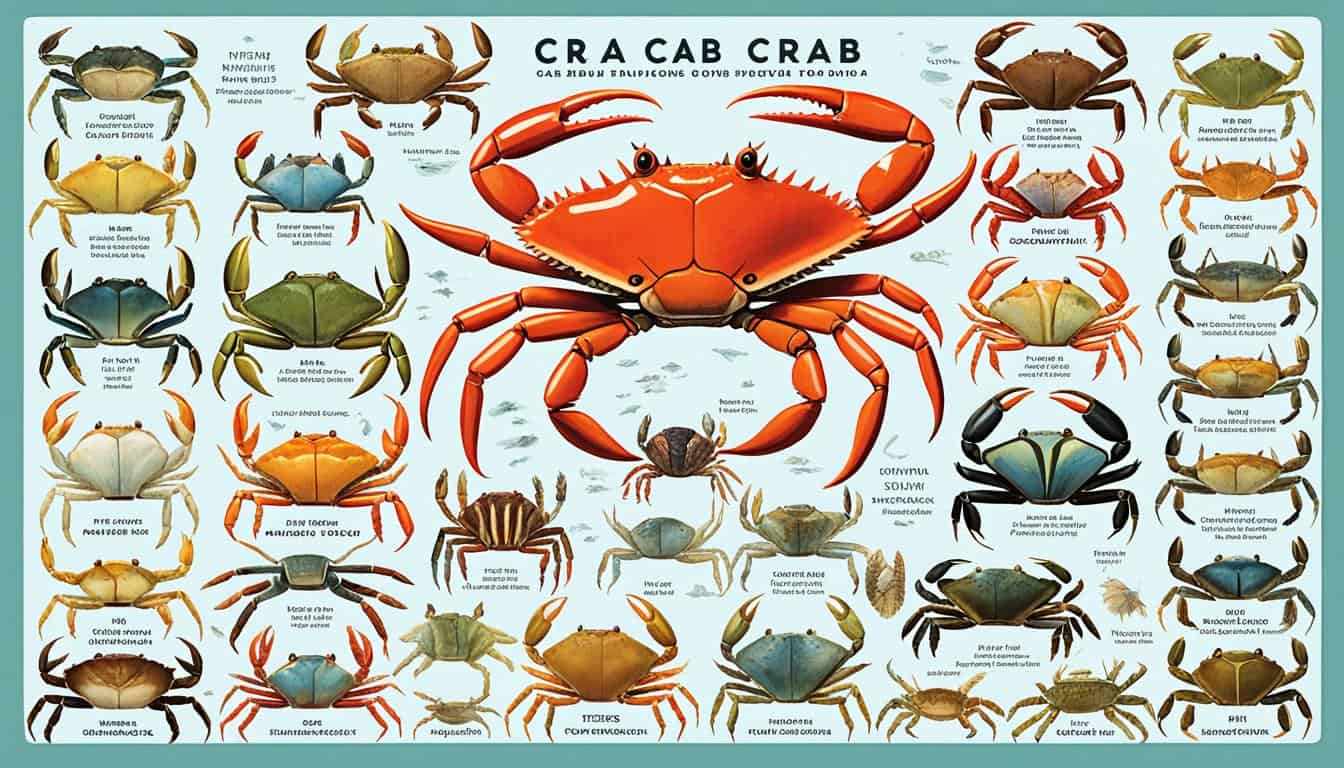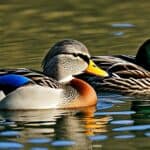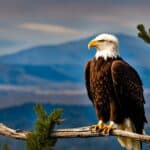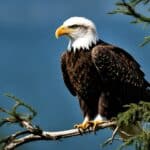Crabs are special decapods with 10 legs and claws. There are around 4,500 types of crabs worldwide. These can be as small as pea crabs or as big as Japanese Spider Crabs. We’re mainly looking at those near the North American coasts.
Understanding their molting is key. This is when they shed their shells to grow. It shows us how crabs have evolved, going back to the Jurassic period.
In this guide, you will learn to tell American crabs apart. Each has its own special features.
Check out this guide to get better at spotting crab species in America. It’s a great way to learn more about these fascinating creatures.
Introduction to Crab Species in America
In the United States, many different crab species can be found. They live all the way from the Pacific to the Atlantic coasts, even in freshwater. If you’re wondering how to spot the crab types in the USA, this guide has the info you need.
To identify crab types in the USA, you look at the shape of their shell, their claws, and the colors they have. Each coast will show you crabs with their own standout looks.
| Species | Carapace Shape | Claw Characteristics | Color Patterns |
|---|---|---|---|
| Dungeness Crab | Oval-shaped | Hooks on claws | Yellow-brown to purple |
| Red Rock Crab | Fan-shaped | Black-tipped claws | Deep brick red |
| Blue Crab | Broad carapace | Sapphire-tinted claws | Mottled brownish |
| Stone Crab | Rounded carapace | Robust claws | Dark brown with gray spots |
Knowing these key points is the first step in identifying crab types in the USA. It helps us understand and enjoy the many crab species in the country.
Essential Identification Features of Crabs
Knowing the main features helps when identifying crabs. This part focuses on key traits. Then, you can get better at spotting crab species correctly.
Carapace Shape and Size
Different crabs have different carapaces. They might have a wide shape or appear more rounded. Think about size and shape when you identify crabs.
Claw Characteristics
Looking at the claws tells you a lot about the crab. Check for hooks or the color at their tips. Different crabs have different claw features that help tell them apart.
Color and Patterns
Crabs come in many colors and patterns. Some are one solid color, others have mixed colors and patterns. Knowing these helps a lot in identifying the species.
Dungeness Crabs
Dungeness crabs are well-known in the United States. They stand out because of their unique features and where they like to live. Knowing these facts makes it easier to spot them.
Carapace Features
The Dungeness crab has an oval-shaped carapace. It can be yellow-brown to purple in color. They also have special hooks on their claws.
Habitat and Distribution
Dungeness crabs live in the North American west coast. They are found from North to South, in places like eelgrass beds and the sea floor. These crabs are very important for business in the Pacific Northwest.
| Feature | Description |
|---|---|
| Carapace Shape | Oval-shaped |
| Carapace Color | Yellow-brown to purple |
| Claw Hooks | Distinctive hooks present |
| Habitat | Sandy or muddy environments |
| Distribution | West coast of North America (Alaska to California) |
Red Rock Crabs
In the USA, Red Rock Crabs are easy to spot. They have unique features and like a specific kind of place to live. Their look makes them different from other crabs in North America.
Physical Characteristics
Red Rock Crabs are known for their fan-shaped carapace and claws with black tips. They are deep brick red, making them stand out in Oregon. These crabs are important in the ecosystems they live in.
Juvenile Colors and Patterns
Young Red Rock Crabs look different and can be confusing. It’s key to know that Pacific Rock Crabs have hairy legs and spots underneath. This helps tell them apart.
- Red Rock Crabs: Deep brick red color, black-tipped claws
- Pacific Rock Crabs: Hairier legs, spotted undersides
Knowing how to spot specific crabs helps everyone. This is important for those who love crabs and for keeping the environment diverse. By looking at certain features, you can figure out identifying crab types in the USA.
Identifying Blue Crabs
Blue Crabs are known as Callinectes sapidus. They have standout features like sapphire claws and a brown shell. It’s important to know these details to spot them easily.
These crabs live from Nova Scotia to the Gulf of Mexico, even in Uruguay. They are known for their delicious taste. Their key features are their blue claws and colorful shells.
Blue Crabs are key in their environments. They are important in the food chain and for the local economy. Learning about them can make your crab experiences more fun and educational.
Stone Crabs Overview
Stone crabs are unique to Florida and stand out because of their looks. You can easily spot them by their dark brown bodies with gray spots. Their strong claws are good at crunching oyster shells. This makes them very interesting for those studying crabs in the U.S.

Claw Characteristics
The claws of stone crabs are strong and key to identifying them. A special fact about these claws is that they can grow back. This shows how adaptable and sustainable the stone crab species is.
| Feature | Description |
|---|---|
| Carapace Color | Dark brown with gray spots |
| Claw Strength | Capable of crushing oyster shells |
| Claw Regeneration | Claws can regenerate after harvesting |
How do you identify different species of crabs in the USA?
Identifying crab species in the USA is challenging yet exciting. Many types look similar at first glance. It helps to know common mistakes and the places these crabs live. This knowledge can make spotting crabs correctly much easier.
Common Misidentifications
Mistaking young crabs for different kinds is a common error. Young Dungeness crabs can look like Green crabs when they molt and change color. Learning about these mistakes can sharpen your crab identification skills.
Understanding Crab Habitats
Different crabs live in different places, from rocky shores to kelp beds. Each type of place shapes how a crab looks and acts. Knowing these environments is key to figuring out which crab is which. When you ask, “How do you identify different species of crabs in the USA?” knowing their homes is part of the answer.
Here are some habitats and the associated species:
| Habitat | Common Crab Species |
|---|---|
| Rocky estuaries | Green Crabs |
| Kelp forests | Red Rock Crabs |
| Sandy ocean floor | Dungeness Crabs |
Knowing where crabs live and how they may be overlooked helps you ID them. This deep knowledge makes crab spotting more effective. It also supports the work to protect crabs and their habitats.
Snow Crab Identification Tips
Snow Crabs, also known as Queen Crabs, stand out due to their unique colors and where they live. Learn about what makes them easy to spot. This will make you better at telling apart US crab types.
Color Variations
Snow Crabs come in various colors, like brown to light red on top. Their bellies can be yellow to white. These colors are key signs that help separate Snow Crabs from other types. Notice the change from dark to light colors, which is a special feature of Snow Crabs. This bright contrast is a big hint when you’re trying to identify Snow Crabs.
Geographical Locations
Snow Crabs live in the cold, deep parts of the northern Pacific and Atlantic Oceans. They like places with shelves and upper slopes, often on sandy or muddy ground. Knowing where Snow Crabs live is important for spotting them. They are specially built for life in colder waters, making them different from other crabs on the American coasts.
FAQ
How do you identify different species of crabs in the USA?
Identifying crabs involves closely looking at their carapace, claws, and color. Knowing types like Dungeness, Red Rock, and Blue Crabs is key. Each has unique marks for ID.
What are the most common crab species found in America?
The top crabs found in the USA are Dungeness, Red Rock, Blue, Stone, and Snow Crabs. They all have special traits and places they call home.
What are the key identification features of crabs?
The main features to note are carapace shape, claw type, and color. These points help tell one crab from another.
How can you identify a Dungeness Crab?
Dungeness Crabs are easy to spot with their oval shell and varied colors. They more often have hooks on their claws. You’ll find them on the west coast’s sandy or muddy areas.
What are the characteristics of Red Rock Crabs?
Red Rock Crabs stand out with their fan-shaped shell and black-tipped claws. They are a deep brick red. Their young can have lots of colors and patterns, not to be confused with Pacific Rock Crabs.
How do you identify Blue Crabs?
Look for Blue Crabs with their blue claws and brownish shell. They’re found from Nova Scotia to Uruguay. People love them for their taste.
What distinguishes Stone Crabs from other species?
Stone Crabs are known for their dark shell with gray spots and strong claws. They live in Florida mostly. People harvest them for their claws, which grow back.
What are common misidentifications of crab species?
People mix up young Dungeness and Green Crabs because they look alike when shedding. Knowing where they live can help tell them apart.
Where are Snow Crabs typically found, and what are their identifying features?
Snow Crabs live in the cold waters of the north. They’re brown to light red on top and pale underneath. People prize them for their meat.
Why is it important to understand different crab habitats?
Each crab type lives in a specific place, from shallow rocks to deep waters. Knowing this helps correctly identify them based on their looks.







